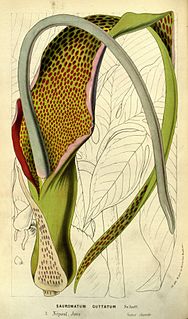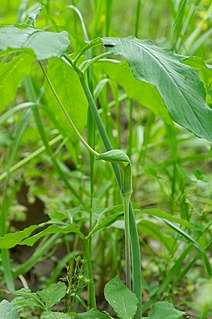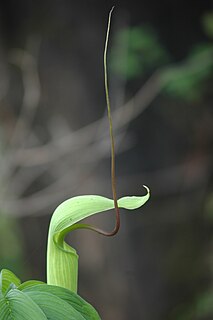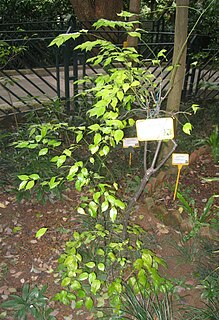
The Araceae are a family of monocotyledonous flowering plants in which flowers are borne on a type of inflorescence called a spadix. The spadix is usually accompanied by, and sometimes partially enclosed in, a spathe or leaf-like bract. Also known as the arum family, members are often colloquially known as aroids. This family of 140 genera and about 3750 known species is most diverse in the New World tropics, although also distributed in the Old World tropics and northern temperate regions.

Amorphophallus is a large genus of some 200 tropical and subtropical tuberous herbaceous plants from the Arum family (Araceae), native to Asia, Africa, Australia and various oceanic islands. A few species are edible as "famine foods" after careful preparation to remove irritating chemicals. The genus includes the Titan arum of Indonesia, which has the largest inflorescence of any plant in the genus, and is also known as the 'corpse flower' for the pungent odour it produces during its flowering period, which can take up through seven years of growth before it occurs.

A raceme or racemoid is an unbranched, indeterminate type of inflorescence bearing pedicellate flowers along its axis. In botany, an axis means a shoot, in this case one bearing the flowers. In indeterminate inflorescence-like racemes, the oldest flowers are borne towards the base and new flowers are produced as the shoot grows, with no predetermined growth limit. A plant that flowers on a showy raceme may have this reflected in its scientific name, e.g. Cimicifuga racemosa. A compound raceme, also called a panicle, has a branching main axis. Examples of racemes occur on mustard and radish plants.

Arisaema is a large and diverse genus of the flowering plant family Araceae. The largest concentration of species is in China and Japan, with other species native to other parts of southern Asia as well as eastern and central Africa, Mexico and eastern North America. Asiatic species are often called cobra lilies, while western species are often called jack-in-the-pulpit; both names refer to the distinctive appearance of the flower, which consists of an erect central spadix rising from a spathe.

Arisaema triphyllum, the jack-in-the-pulpit, bog onion, brown dragon or Indian turnip, is a herbaceous perennial plant growing from a corm. It is a highly variable species typically growing 30–65 centimetres (12–26 in) in height with three-part leaves and flowers contained in a spadix that is covered by a hood. It is native to eastern North America, occurring in moist woodlands and thickets from Nova Scotia west to Minnesota, and south to southern Florida and Texas.

Arum is a genus of flowering plants in the family Araceae, native to Europe, northern Africa, and western and central Asia, with the highest species diversity in the Mediterranean region. Frequently called arum lilies, they are not closely related to the true lilies Lilium. Plants in closely related Zantedeschia are also called "arum lilies".

Sauromatum venosum is a species of plant in the arum family, Araceae. It is native to Asia and Africa, where it grows in forests and riparian meadows.

Arisaema dracontium, the dragon-root or green dragon, is a herbaceous perennial plant in the genus Arisaema and the family Araceae. It is native to North America from Quebec through Minnesota south through Florida and Texas, where it is found growing in damp woods. It has also been reported from northeastern Mexico Plants grow 20–50 centimetres (7.9–19.7 in) tall when in bloom and after flowering reach 100 centimetres (39 in), and each grows from a corm. Normally, a plant produces one leaf with a long petiole, its leaf is composed of 7 to 13 leaflets, with its central leaflet being the largest one and with leaflets becoming smaller as they are produced distally, the leaflets are held out horizontally over the plant. During flowering in spring, a single slender, green spathe 3–6 centimetres (1.2–2.4 in) long is produced; it covers a tapering, long thin spadix. The tail-like spadix grows out around the top of its spathe. After flowering, up to 150 berries are produced in a club-shaped column. In late summer, the green berries turn orange-red, each berry produces 1 to 3 seeds. It is listed as a vulnerable species in Canada.

Arisaema tortuosum, the whipcord cobra lily, is a plant species in the family Araceae. It has a distinctive purple or green whip-like spadix which arises from the mouth of its "jack-in the-pulpit" flower and may be up to 30 cm long. Flowers may be male or bisexual. The clustered fruits are green at first, ripening to red. The plant grows in large clumps and can be up to 2 metres in height.

Anubias afzelii is a species belonging to the Aroid genus Anubias. It was first described scientifically by Heinrich Wilhelm Schott in 1857, based on material collected in Sierra Leone by Adam Afzelius, after whom the species was named. The genus Anubias was described simultaneously, with only A. afzellii belonging to it, which therefore is the type species of the genus. No other species currently placed in the genus Anubias was described earlier and A. afzelii was therefore the first species of this genus known to science.

Anubias heterophylla is a species belonging to the Aroid genus Anubias. It was first described scientifically by Adolf Engler in 1879.

Arisaema candidissimum is a species of flowering plant in the arum family (Araceae), originating in western China. Various English names have been given to the species, including Chinese cobra lily and Chinese jack-in-the-pulpit. The Chinese name is 白苞南星.

Arisaema propinquum, or Wallach's cobra lily, is a species of flowering plant the family Araceae. Arisaema propinquum occurs in the Himalayas.
Anubias pynaertii is a species belonging to the Aroid genus Anubias. It was first described scientifically by Émile Auguste Joseph De Wildeman in 1910, based on material collected in Zaire by, among others, Léon Auguste Edouard Joseph Pynaert, after whom the species was named.

Anubias hastifolia is a species belonging to the Aroid genus Anubias. It was first mentioned by Adolf Engler in 1889 and described scientifically by him in 1893.

Ilex asprella, also known as rough-leaved holly and plum-leaved holly, is a deciduous shrub native in South East Asia. Ilex asprella is one of the few deciduous species in the family Aquifoliaceae.

Remusatia vivipara also called hitchhiker elephant ear is a perennial herb growing up to 50 cm tall in the genus Remusatia. It is widespread throughout the world, growing in temperate climates.

Arisaema serratum is a species of flowering plant in the arum family (Araceae). It is native Japan, where it is found from the Kansai region north to the island of Hokkaido. Its natural habitat is damp forests.

Arum cylindraceum is a woodland plant species of the family Araceae. It is found in most of Europe except the UK, Russia, Ukraine, Belarus, the Baltic States and Scandinavia, and in Turkey. It is also missing in northwestern France and southern Italy.

Arisaema consanguineum, the Himalayan cobra lily, is a species of flowering plant in the arum lily family Araceae. Native to the Himalayas and Indochina, it is a tuberous perennial. A single stem, 1 m (3.3 ft) tall, bears a deciduous leaf with multiple radial leaflets. The flower is a deep maroon hooded spathe striped green and white. It appears in summer, and is followed by a cluster of brilliant red berries in autumn.



















